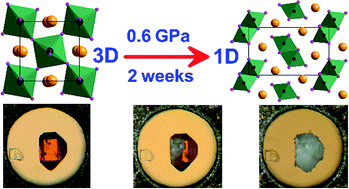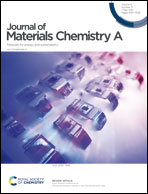Time-dependent transformation routes of perovskites CsPbBr3 and CsPbCl3 under high pressure†
Abstract
All-inorganic halide perovskites are prospective materials for diverse applications in photovoltaic and optoelectronic devices. Their high performance is associated with good operational stability, which is the key problem of hybrid organic–inorganic perovskites. However, for these materials only fragmentary information is available on the mechanical robustness and response to external stress, fundamentally important for strain engineering in multilayers, pressure-assisted technologies, and flexible panels applications. Here we show that all-inorganic perovskites CsPbX3 (where X = Cl, Br) undergo various types of pressure-induced transformations, including reversible phase transitions, irreversible chemical reactions reducing the dimensionality of PbX6 frameworks, and amorphization. The transformation routes depend on the mode of the applied stress and are related to the kinetics of transitions to the most stable phases. The slow-kinetics transformations in a moderate pressure range of technological importance, between 0.5 and 1.5 GPa, can require days or even weeks, depending on the sample quality and external stimuli. The pressure-induced narrowing and widening of energy gaps has been explained by the mechanism combining Pb–X bond lengths and PbX6 octahedra tilts with the electronic structure of the crystals.



 Please wait while we load your content...
Please wait while we load your content...